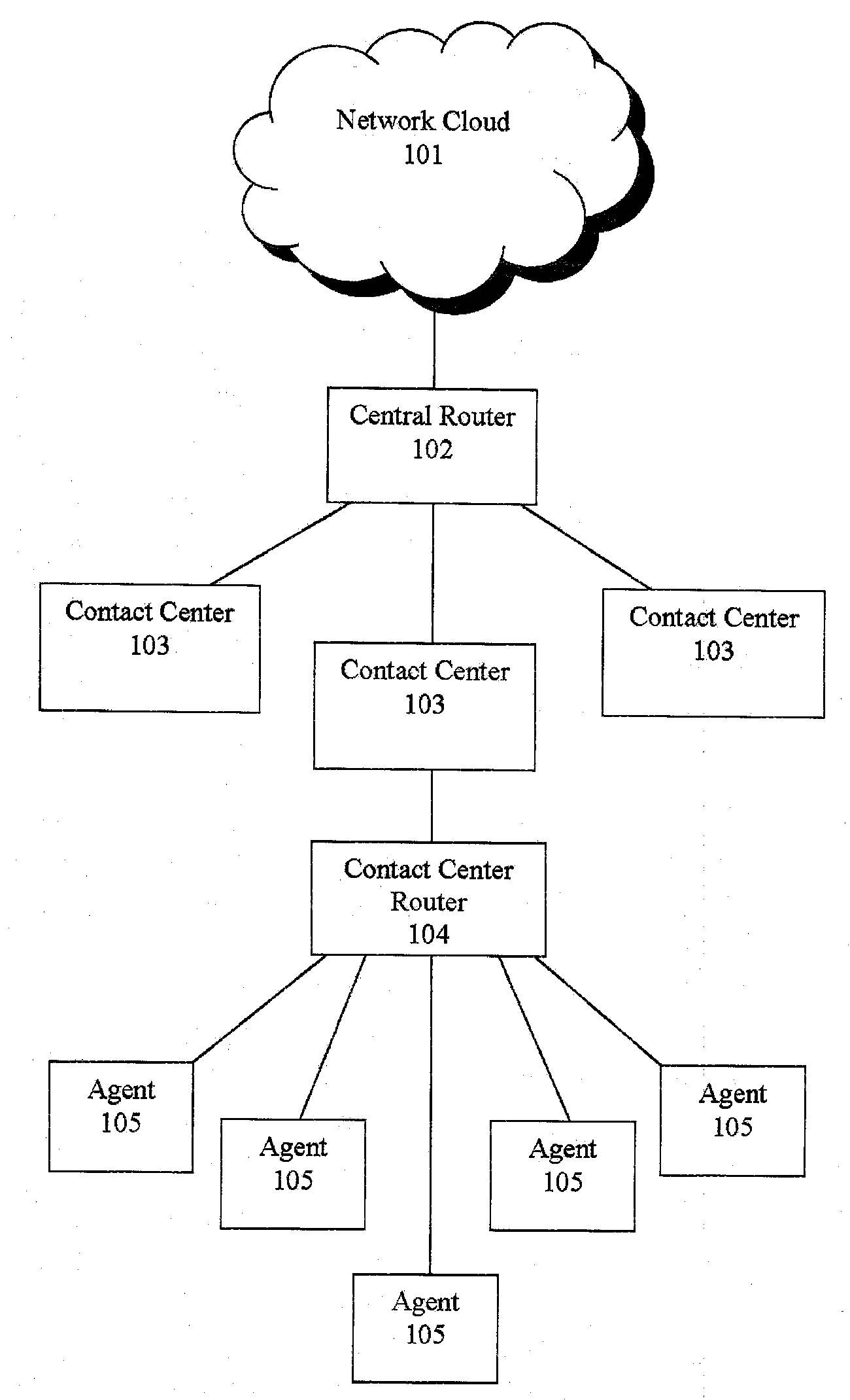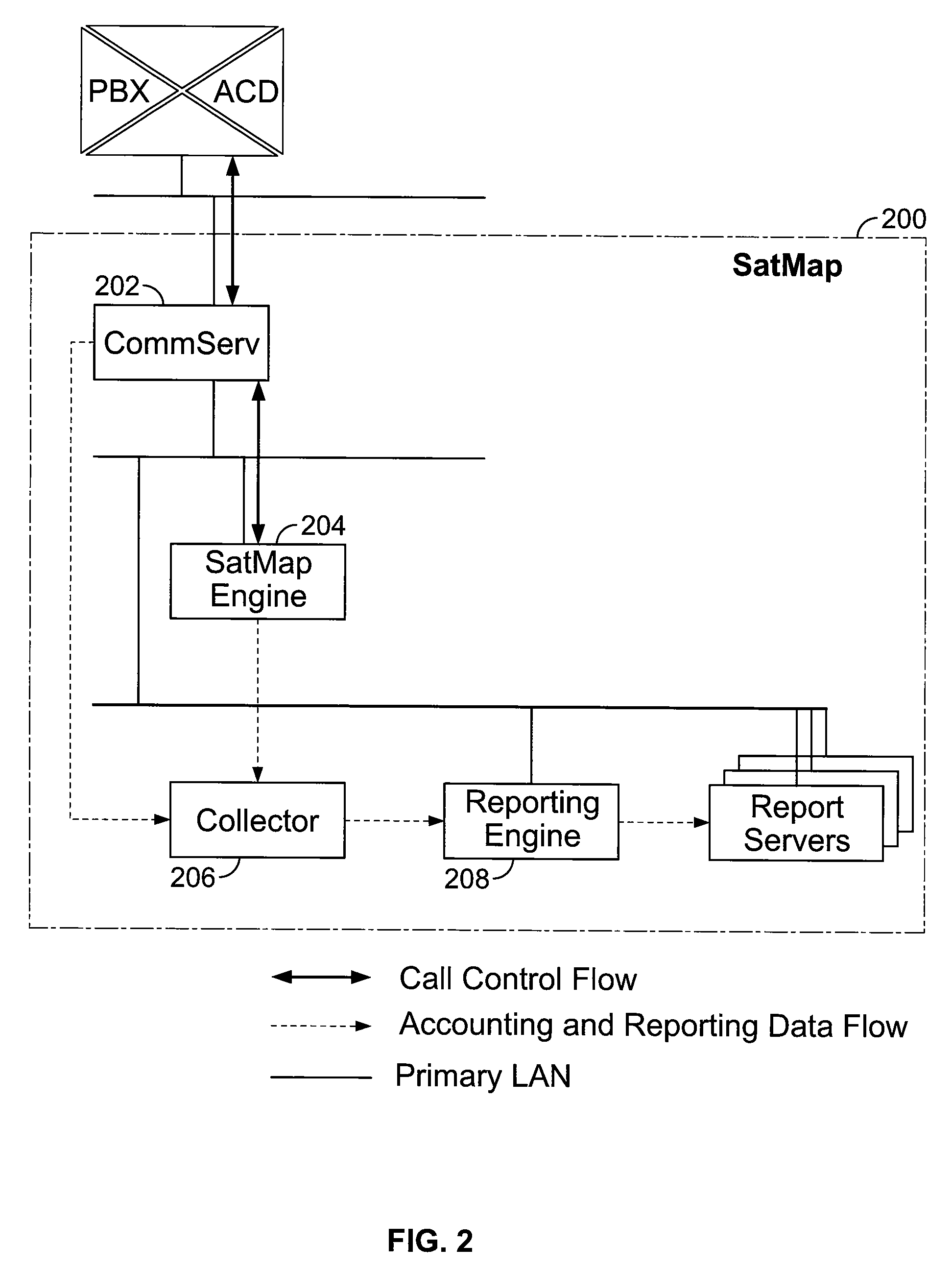[0015]Various performance based and / or
pattern matching algorithms for matching callers and agents based on available information regarding each may be utilized. In general, contact center routings are potentially improved or optimized by routing contacts such that callers are matched with and connected to particular agents in a manner that increases the chance of an interaction that is deemed beneficial to a contact center (referred to in this application as an “optimal interaction”). Examples of optimal interactions include increasing sales, decreasing the duration of the contact (and hence the cost to the contact center), providing for an acceptable level of customer satisfaction, or any other interaction that a contact center may seek to control or improve. The systems and methods of the present invention can improve the chance of an optimal interaction by, in general, grading agents on an optimal interaction, and matching a graded agent with a caller to increase the chance of the optimal interaction. Once matched, the caller can be connected to the graded agent. In a more advanced embodiment, the systems and methods of the present invention can also be used to increase the chance of an optimal interaction by matching a caller to an agent using a computer model derived from data describing demographic, geographic, psychographic, past purchase behavior, personality characteristics (e.g., via a Myers-Brigg Type Indicator test or the like), time effects (e.g., data associated with different times of the day, week, month, etc.) or other
relevant information about a caller, together with data describing demographic, geographic, psychographic, personality characteristics, time effects, or historical performance about an agent.
[0016]In a relatively basic example, the performance of a contact center's agents is collated over a period time to grade each agent on their ability to achieve an optimal interaction. The period of time can be as short as the immediately prior contact to a period extending as long as the agent's first interaction with a caller. The grade determined for the each agent is then used as a factor in matching and connecting a caller to a particular agent. For example, certain agents may be shown to have a greater ability to generate sales than that of other agents engaged in the same contact center. Such examples, by preferentially routing callers to those agents shown to have greater ability to generate sales, can increase the chances of achieving greater sales during the contacts. Similarly, other agents may be shown to generate shorter interactions with callers than that of other agents at the same contact center. By preferentially routing contacts to the agents shown to generate shorter interactions with callers, a contact center or contact center
client can decrease its overall need for agents and
communication bandwidth, and therefore, reduce its costs.
[0024]Though this advanced embodiment preferably uses agent grades, demographic, psychographic, and other business-relevant data, along with caller demographic, psychographic, and other business-relevant data, other embodiments can eliminate one or more types or categories of caller or agent data to minimize the computing power or storage necessary to employ the exemplary methods and systems.
[0032]Exemplary methods and systems can also comprise connection rules to define when or how to connect agents that are matched to a caller. The connection rules can be as simple as instructing the method or system to connect a caller according to the best match among all available agents with that particular caller. In this manner, caller
hold time can be minimized. The connection rules can also be more involved, such as instructing the method or system to connect a caller only when a minimum threshold match exists between an available agent and a caller, or to allow a defined period of time to search for a minimum matching or the best available matching at that time. The connection rules can also purposefully keep certain agents available while a search takes place for a potentially better match.
[0035]In a more advanced embodiment, the present invention can be used to create an intelligent routing system, the system comprising means for determining at least one agent data for each of two or more agents, determining at least one caller data for a caller, means for using the agent data and the caller data in a pattern matching
algorithm, and means for matching the caller to one of the two or more agents to increase the chance of an optimal interaction. Means for determining agent data can comprise the use of manual or automatic surveys, which can be recorded in hardcopy or
electronic form, such as through the use of
computer memory containing databases for storing such information. Means for determining caller data can comprise the use of
computer memory containing a
database with caller data, such as a commercially-available
database,
client database, or contact center database. Means for determining caller data can also comprise the use of a CallerID device as well as
telephony or other
telecommunications equipment for receiving a caller's account number or other caller-identifying information. Means for using the agent data and the caller data in a pattern matching
algorithm can comprise a computational device. Means for matching the caller to one of the two or more agents can also comprise the use of a computational device. This embodiment of the intelligent routing system can also comprise means for connecting the caller with one of the two or more agents, such as a switching or routing system. The system can also comprise means for contacting a caller, such as a
dialer or
telephony equipment that can be used by an agent to contact the caller.
 Login to View More
Login to View More  Login to View More
Login to View More 


